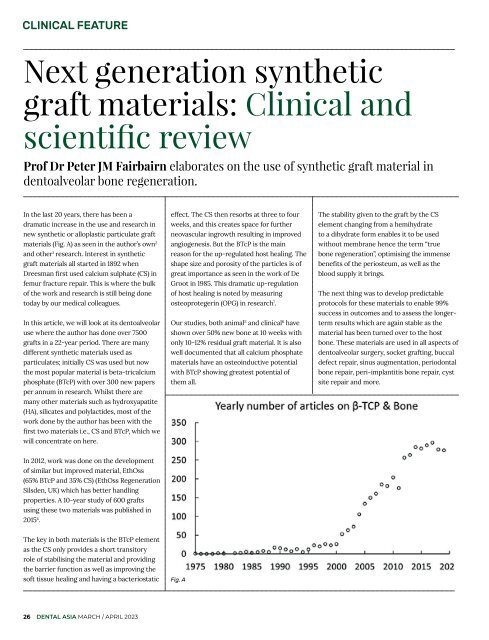Dental Asia March/April 2023
For more than two decades, Dental Asia is the premium journal in linking dental innovators and manufacturers to its rightful audience. We devote ourselves in showcasing the latest dental technology and share evidence-based clinical philosophies to serve as an educational platform to dental professionals. Our combined portfolio of print and digital media also allows us to reach a wider market and secure our position as the leading dental media in the Asia Pacific region while facilitating global interactions among our readers.
For more than two decades, Dental Asia is the premium journal in linking dental innovators
and manufacturers to its rightful audience. We devote ourselves in showcasing the latest dental technology and share evidence-based clinical philosophies to serve as an educational platform to dental professionals. Our combined portfolio of print and digital media also allows us to reach a wider market and secure our position as the leading dental media in the Asia Pacific region while facilitating global interactions among our readers.
Create successful ePaper yourself
Turn your PDF publications into a flip-book with our unique Google optimized e-Paper software.
CLINICAL FEATURE<br />
Next generation synthetic<br />
graft materials: Clinical and<br />
scientific review<br />
Prof Dr Peter JM Fairbairn elaborates on the use of synthetic graft material in<br />
dentoalveolar bone regeneration.<br />
In the last 20 years, there has been a<br />
dramatic increase in the use and research in<br />
new synthetic or alloplastic particulate graft<br />
materials (Fig. A) as seen in the author’s own 2<br />
and other 1 research. Interest in synthetic<br />
graft materials all started in 1892 when<br />
Dreesman first used calcium sulphate (CS) in<br />
femur fracture repair. This is where the bulk<br />
of the work and research is still being done<br />
today by our medical colleagues.<br />
In this article, we will look at its dentoalveolar<br />
use where the author has done over 7500<br />
grafts in a 22-year period. There are many<br />
different synthetic materials used as<br />
particulates; initially CS was used but now<br />
the most popular material is beta-tricalcium<br />
phosphate (BTcP) with over 300 new papers<br />
per annum in research. Whilst there are<br />
many other materials such as hydroxyapatite<br />
(HA), silicates and polylactides, most of the<br />
work done by the author has been with the<br />
first two materials i.e., CS and BTcP, which we<br />
will concentrate on here.<br />
effect. The CS then resorbs at three to four<br />
weeks, and this creates space for further<br />
neovascular ingrowth resulting in improved<br />
angiogenesis. But the BTcP is the main<br />
reason for the up-regulated host healing. The<br />
shape size and porosity of the particles is of<br />
great importance as seen in the work of De<br />
Groot in 1985. This dramatic up-regulation<br />
of host healing is noted by measuring<br />
osteoprotegerin (OPG) in research 7 .<br />
Our studies, both animal 5 and clinical 6 have<br />
shown over 50% new bone at 10 weeks with<br />
only 10-12% residual graft material. It is also<br />
well documented that all calcium phosphate<br />
materials have an osteoinductive potential<br />
with BTcP showing greatest potential of<br />
them all.<br />
The stability given to the graft by the CS<br />
element changing from a hemihydrate<br />
to a dihydrate form enables it to be used<br />
without membrane hence the term “true<br />
bone regeneration”, optimising the immense<br />
benefits of the periosteum, as well as the<br />
blood supply it brings.<br />
The next thing was to develop predictable<br />
protocols for these materials to enable 99%<br />
success in outcomes and to assess the longerterm<br />
results which are again stable as the<br />
material has been turned over to the host<br />
bone. These materials are used in all aspects of<br />
dentoalveolar surgery, socket grafting, buccal<br />
defect repair, sinus augmentation, periodontal<br />
bone repair, peri-implantitis bone repair, cyst<br />
site repair and more.<br />
In 2012, work was done on the development<br />
of similar but improved material, EthOss<br />
(65% BTcP and 35% CS) (EthOss Regeneration<br />
Silsden, UK) which has better handling<br />
properties. A 10-year study of 600 grafts<br />
using these two materials was published in<br />
2015 4 .<br />
The key in both materials is the BTcP element<br />
as the CS only provides a short transitory<br />
role of stabilising the material and providing<br />
the barrier function as well as improving the<br />
soft tissue healing and having a bacteriostatic<br />
Fig. A<br />
26 DENTAL ASIA MARCH / APRIL <strong>2023</strong>


















